
Back Eland pantserkar Afrikaans إيلاند أم كيه7 Arabic Eland Mk7 Polish Eland Mk7 Portuguese Eland (бронеавтомобіль) Ukrainian
| Eland Mk7 | |
|---|---|
 Eland Mk7 at the Tempe School of Armour, Bloemfontein | |
| Type | Armoured car |
| Place of origin | South Africa |
| Service history | |
| In service | 1962–1994 (South Africa)[1] 1967–present (other)[2] |
| Used by | See Operators |
| Wars | |
| Production history | |
| Designer | Sandock-Austral |
| Designed | 1962[3] |
| Manufacturer | Sandock-Austral Reumech OMC |
| Produced | 1964[3] – 1986[4][5] |
| No. built | 1,600[6] |
| Variants | See Variants |
| Specifications | |
| Mass | 6 tonnes (6.6 short tons; 5.9 long tons)[7] |
| Length | 5.12 m (16 ft 10 in)[7] |
| length | 4.04 m (13 ft 3 in) (hull)[7] |
| Width | 2.01 m (6 ft 7 in)[7] |
| Height | 2.5 m (8 ft 2 in)[7] |
| Crew | 3 (commander, driver, gunner)[8] |
Main armament | 90mm Denel GT-2 (29 rounds) OR 60mm K1 mortar (56 rounds) |
Secondary armament | 2x 7.62mm M1919 Browning machine guns[9] (2400 - 3800 rounds)[8] |
| Engine | Chevrolet 153 2.5 L (150 in3) inline 4-cylinder water-cooled petrol[9] |
| Transmission | 6-speed manual constant mesh[8] |
| Suspension | Independent 4X4; active trailing arms[8] |
| Ground clearance | 380 mm (1 ft 3 in)[8] |
| Fuel capacity | 142 L (38 US gal)[8] |
Operational range | 450 km (280 mi)[7] |
| Maximum speed | 100 km/h (62 mph)[6] |
The Eland is an air-portable[10] light armoured car based on the Panhard AML.[9] Designed and built for long-range reconnaissance,[11] it mounts either a 60mm (2.4 in) breech-loading mortar or a Denel 90mm (3.5 in) gun on a very compact chassis.[9][12] Although lightly armoured, the vehicle's permanent 4X4 drive makes it faster over flat terrain than many tanks.[13]
The Eland was developed for the South African Defence Force (SADF) in South Africa's first major arms programme since World War II, with prototypes completed in 1963.[14] By 1991, 1,600 examples had been built for home and export;[6] prominent foreign operators included Morocco and Zimbabwe.[2] Local overhauls incorporating lessons from internal operations have resulted in a vehicle capable of withstanding the unforgiving Southern African environment and highly mobile operational style of the SADF.[8]
- ^ Armoured Car, Eland Mk7/90 (RSA) (Gate exhibit), South African Armour Museum, Bloemfontein: South African National Defence Force, 2014
- ^ a b "Trade Registers". Armstrade.sipri.org. Retrieved 2013-06-20.
- ^ a b "Lesakeng". South African Armour Museum. 2012-12-06. Archived from the original on 2013-07-03. Retrieved 2013-06-18.
- ^ Henk, Daniel (2006). South Africa's armaments industry: continuity and change after a decade of majority rule (2006 ed.). University Press America. p. 164. ISBN 978-0761834823.
- ^ Ogorkiewicz, Richard (2015). Tanks: 100 Years of Evolution. Oxford, UK: Osprey Publishing. ISBN 9781472806703.
- ^ a b c Landgren, Signe (1989). Embargo Disimplemented: South Africa's Military Industry (1989 ed.). Oxford University Press. pp. 83–88. ISBN 978-0-19-829127-5.
- ^ a b c d e f Heitman, Helmoed-Römer. South African Armed Forces. Buffalo Publications 1990. ISBN 0-620-14878-0 p 44.
- ^ a b c d e f g Heitman, Helmoed-Römer. South African Arms and Armour - A concise guide to armaments of the South African Army, Navy, and Air Force. Struik Publishers 1988. ISBN 0-86977-637-1 p 44-45.
- ^ a b c d "Restoration of the Eland-60". Sandstone Estates. 2012-12-06. Archived from the original on February 1, 2014. Retrieved 2013-06-18.
- ^ "Fact file: Rooikat armoured car". Defence Web. 2010-01-21. Retrieved 2013-06-18.
- ^ "AML-90". 61mech.org.za. Retrieved 2013-06-18.
- ^ Cite error: The named reference
Bellwas invoked but never defined (see the help page). - ^ "How Green We Were". Sentinel Projects. 2000. Retrieved 2013-08-09.
- ^ Christopher F. Foss (2001). Jane's Armour and Artillery (2002 ed.). Macdonald and Jane's Publishers Ltd. pp. 244–245. ISBN 978-0710623096.
© MMXXIII Rich X Search. We shall prevail. All rights reserved. Rich X Search